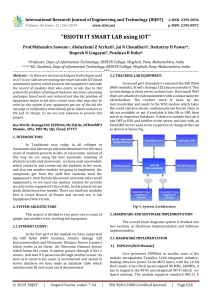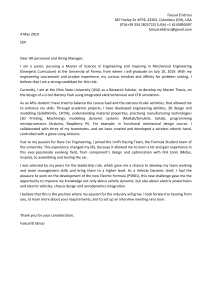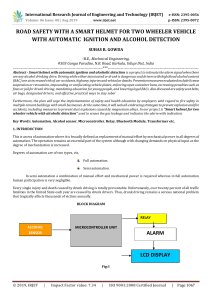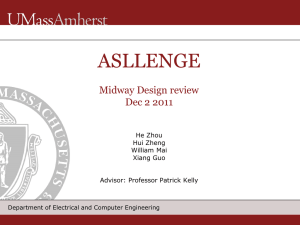IRJET-IoT based Smart Helmet for Coal Mining Tracking
advertisement
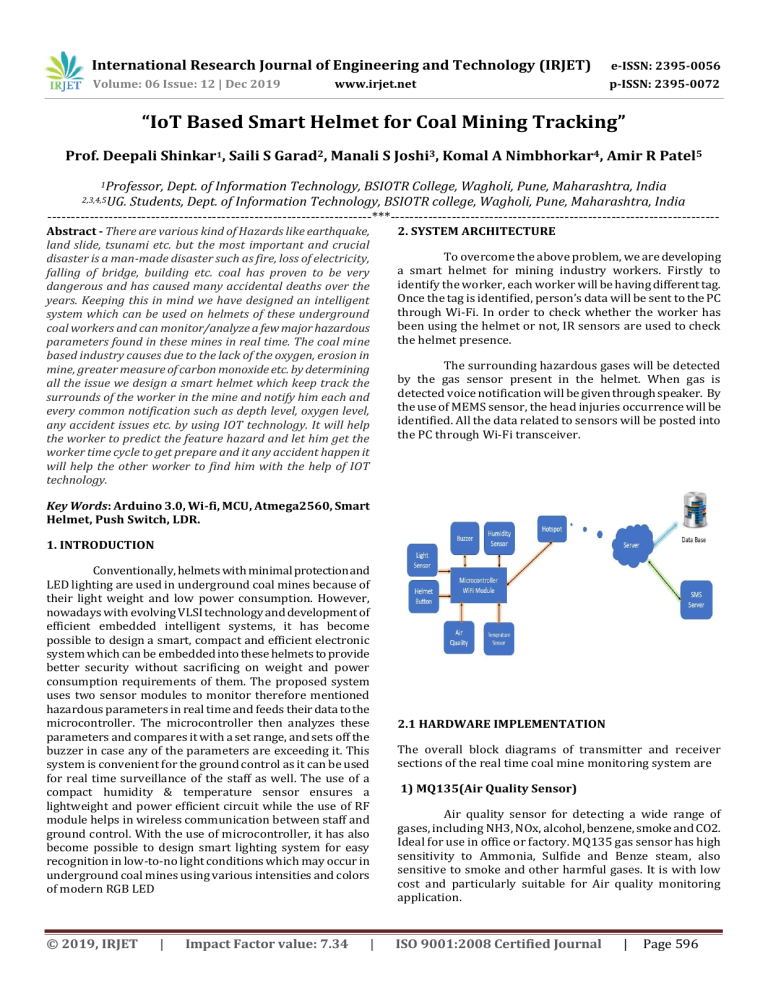
International Research Journal of Engineering and Technology (IRJET) e-ISSN: 2395-0056 Volume: 06 Issue: 12 | Dec 2019 p-ISSN: 2395-0072 www.irjet.net “IoT Based Smart Helmet for Coal Mining Tracking” Prof. Deepali Shinkar1, Saili S Garad2, Manali S Joshi3, Komal A Nimbhorkar4, Amir R Patel5 1Professor, Dept. of Information Technology, BSIOTR College, Wagholi, Pune, Maharashtra, India Students, Dept. of Information Technology, BSIOTR college, Wagholi, Pune, Maharashtra, India ---------------------------------------------------------------------***---------------------------------------------------------------------2,3,4,5UG. Abstract - There are various kind of Hazards like earthquake, land slide, tsunami etc. but the most important and crucial disaster is a man-made disaster such as fire, loss of electricity, falling of bridge, building etc. coal has proven to be very dangerous and has caused many accidental deaths over the years. Keeping this in mind we have designed an intelligent system which can be used on helmets of these underground coal workers and can monitor/analyze a few major hazardous parameters found in these mines in real time. The coal mine based industry causes due to the lack of the oxygen, erosion in mine, greater measure of carbon monoxide etc. by determining all the issue we design a smart helmet which keep track the surrounds of the worker in the mine and notify him each and every common notification such as depth level, oxygen level, any accident issues etc. by using IOT technology. It will help the worker to predict the feature hazard and let him get the worker time cycle to get prepare and it any accident happen it will help the other worker to find him with the help of IOT technology. 2. SYSTEM ARCHITECTURE To overcome the above problem, we are developing a smart helmet for mining industry workers. Firstly to identify the worker, each worker will be having different tag. Once the tag is identified, person’s data will be sent to the PC through Wi-Fi. In order to check whether the worker has been using the helmet or not, IR sensors are used to check the helmet presence. The surrounding hazardous gases will be detected by the gas sensor present in the helmet. When gas is detected voice notification will be given through speaker. By the use of MEMS sensor, the head injuries occurrence will be identified. All the data related to sensors will be posted into the PC through Wi-Fi transceiver. Key Words: Arduino 3.0, Wi-fi, MCU, Atmega2560, Smart Helmet, Push Switch, LDR. 1. INTRODUCTION Conventionally, helmets with minimal protection and LED lighting are used in underground coal mines because of their light weight and low power consumption. However, nowadays with evolving VLSI technology and development of efficient embedded intelligent systems, it has become possible to design a smart, compact and efficient electronic system which can be embedded into these helmets to provide better security without sacrificing on weight and power consumption requirements of them. The proposed system uses two sensor modules to monitor therefore mentioned hazardous parameters in real time and feeds their data to the microcontroller. The microcontroller then analyzes these parameters and compares it with a set range, and sets off the buzzer in case any of the parameters are exceeding it. This system is convenient for the ground control as it can be used for real time surveillance of the staff as well. The use of a compact humidity & temperature sensor ensures a lightweight and power efficient circuit while the use of RF module helps in wireless communication between staff and ground control. With the use of microcontroller, it has also become possible to design smart lighting system for easy recognition in low-to-no light conditions which may occur in underground coal mines using various intensities and colors of modern RGB LED © 2019, IRJET | Impact Factor value: 7.34 | 2.1 HARDWARE IMPLEMENTATION The overall block diagrams of transmitter and receiver sections of the real time coal mine monitoring system are 1) MQ135(Air Quality Sensor) Air quality sensor for detecting a wide range of gases, including NH3, NOx, alcohol, benzene, smoke and CO2. Ideal for use in office or factory. MQ135 gas sensor has high sensitivity to Ammonia, Sulfide and Benze steam, also sensitive to smoke and other harmful gases. It is with low cost and particularly suitable for Air quality monitoring application. ISO 9001:2008 Certified Journal | Page 596 International Research Journal of Engineering and Technology (IRJET) e-ISSN: 2395-0056 Volume: 06 Issue: 12 | Dec 2019 p-ISSN: 2395-0072 www.irjet.net 5) LDR A Light Dependent Resistor (LDR) or a photo resistor is a device whose resistivity is a function of the incident electromagnetic radiation. Hence, they are light sensitive devices. They are also called as photo conductors, photo conductive cells or simply photocells. 2)DHT11(Temperature-Humidity sensor) The DHT11 is a basic, ultra low-cost digital temperature and humidity sensor. It uses a capacitive humidity sensor and a thermistor to measure the surrounding air, and spits out a digital signal on the data pin (no analog input pins needed). Its fairly simple to use, but requires careful timing to grab data. The only real downside of this sensor is you can only get new data from it once every 2 seconds, so when using our library, sensor readings can be up to 2 seconds old. 2.2. SOFTWARE IMPLEMENTATION 1) NodeMCU LUA We used the Node MCU IDE to program the Wi-Fi Module using the Lua Programming Language. NodeMCU is an open source IoT platform. It includes firmware which runs on the ESP8266 Wi-Fi SoC Espress if Systems, and hardware which is based on the ESP-12 module. The term "NodeMCU" is by default refers to the firmware rather than the Dev. kits. The firmware uses the Lua scripting language. It is based on the Lua project and built on the Espressif Non-OS SDK for ESP8266. It uses many open source projects, such as lua-cjson and spiffs. 3) Push switch Many Push switches are designed to function as both push to make and push to break switches. For these switches, the wiring of the switch determines whether the switch functions as a push to make or as a push to break switch. 2) Coffee Cup HTML Editor: To design the Web Page using PHP, HTML 5 and Java Script are used .The CoffeeCup HTML Editor is an HTML editor which can supports both raw HTML and editing. The WYSIWYG editing is no longer available in the newer versions, starting in 2012, (after version 12.5). Originally created by Nicholas Longo and Kevin Jurica, it was first released to the public in August 1996. 4) Light sensor The light sensor is a passive devices that convert this “light energy” whether visible or in the infra-red parts of the spectrum into an electrical signal output. Light sensors are more commonly known as “Photoelectric Devices”or“Photo Sensors” because the convert light energy (photons) into electricity (electrons). According to the journalists the editor was the first to support Java script (version 3.5 Sep. 1996), split-screen editing (version 4.0, March 1997) and built-in FTP upload (version 5.2, February 1998). The HTML Editor was selected Best Windows HTML Editor in the About.com Readers' Choice Awards two years in a row in 2011 and 2012. 3) NetBeans IDE (PHP Website): To design the Website for server side algorithm. PHP (recursive acronym for PHP: Hypertext Preprocessor) is a widely-used .it is open source general-purpose scripting language that is especially suited for web development and can be embedded into HTML. © 2019, IRJET | Impact Factor value: 7.34 | ISO 9001:2008 Certified Journal | Page 597 International Research Journal of Engineering and Technology (IRJET) e-ISSN: 2395-0056 Volume: 06 Issue: 12 | Dec 2019 p-ISSN: 2395-0072 www.irjet.net PHP is a general-purpose scripting language that is especially suited to server-side web development, in which case PHP generally runs on a web server. Any PHP code in a demanded file is executed by the PHP runtime, usually to create dynamic web page content or dynamic images used on websites or elsewhere. PHP is a server-side scripting language designed primarily for web development. It is also used as a general-purpose programming language. Originally created by Rasmus Lerdorf in 1994, the PHP reference execution is now produced by The PHP Development Team. 4) Atmel Studio: 7) FileZilla Web Client: We use the FileZilla Web client for uploading our website to the Server of the 000Webhost. With this client side software it is easy to upload the all contents of our local website file in one click. 1. First we are going to initialize all sensors and hardware setup with the setup loop code from the ESp8266 microcontroller. Atmel Studio is use to provides a large set of features for project development and debugging. The most features are listed below. 2. Then we will establish the connection with the Local Hotspot or with the Internet enabled router for sending the data to our server. Rich code editor for C/C++ and Assembly featuring the powerful Visual Assist extension 3. At service we have the Getalldata.php page script which are going to accept all the sensors value that we are send using the REST API to our server. It has Cycle correct simulator with advanced debug functionality Atmel Software Framework allowing creation of modular applications and providing building blocks for a prototype on any AVR platform Debugging on actual devices using Debugging Tools Rich SDK to enable tight integration of customer plugins 4. The photo script will separate out each sensors data and will insert that data in respective column of our MySQL database table. 5. After that the same script will check for threshold limits of sensors if any value is above the threshold limit that we have sent then Alert. php page script will gets called by previous page. 6. The alert will sent to the Admin and respective in charge of mine industry using the Fast2sms 3rd part api call. 5) Arduino IDE: To Program the Atmega328 Microcontroller we used this IDE. Arduino microcontrollers are pre-programmed with a boot loader that simplifies uploading of programs to the on-chip flash memory. The default boot loader of the Arduino UNO is the boot-loader. Boards are loaded with program code via a serial connection to another computer. Some serial Arduino boards contain a level shifter circuit which is use to convert between RS-232 logic levels and transistor–transistor logic (TTL) level signals. Current Arduino boards are programmed via Universal Serial Bus (USB), implemented using USB-to-serial adapter chips such as the FTDI FT232. Some boards, such as later-model Uno boards, substitute the FTDI chip with a separate AVR chip containing USB-to-serial firmware, which is reprogrammable via its own ICSP header. Other alternates, such as the Arduino Mini and the unofficial Boarduino, use a removable USB-to-serial adapter board or cable, Bluetooth or other methods, when used with customary microcontroller tools instead of the Arduino IDE, standard AVR in-system programming (ISP) programming is used. © 2019, IRJET To Build the PHP web Server for PMC Corporation website using the XAMPP Local Host. XAMPP can Build PHP websites with the MySQL Data base and with Apache server. 3. Algorithm To Program the Atmega328 Microcontroller we used this IDE. 6) Xampp IDE: | Impact Factor value: 7.34 | 4. CONCLUSION A smart mining helmet was developed that is able to detect three types of hazardous events such as danger level of hazardous gases, miner helmet removing, and collision impact.Monitoring and reduction of the number of casualties and providing immediate help to the miners in distress were the main goals of this project. 5. REFERENCES 1) S. R. Deokar, V. M. Kulkarni, J. S. Wakode ,“Smart Helmet for Coal Mines Safety Monitoring and Alerting” Vol. 6, Issue 7, July 2017 2) http://internetofthingsagenda.techta rget.com/definition/Internetof- Things-IoT 3) https://en.wikipedia.org/wiki/Zigbee ISO 9001:2008 Certified Journal | Page 598 International Research Journal of Engineering and Technology (IRJET) e-ISSN: 2395-0056 Volume: 06 Issue: 12 | Dec 2019 p-ISSN: 2395-0072 www.irjet.net 4) Kiran Kishore V, E Narasimha and Y Shruthi, ,“smart helmet for coal miners using zigbee technology” Issue-2, Volume-2, 067069 5) https://www.techopedia.com/defini tion/27874/arduino 6) arduino.cc/en/uploads/main/arduin onanomanual23.pdf 7) https://www.cnx- software.com/2015/04/18/nodemcu is-both-abreadboard-friendly- esp8266-wi-fi-board-and-alua- basedfirmware 8) https://en.wikipedia.org/wiki/Node MCU 9) https://en.wikipedia.org/wiki/Thing Speak 10) C. j. Behr, A. Kumar and G. P. Hancke, „A Smart Helmet for Air Quality and Hazardous Event Detection for the Industry‟, IEEE, PP. 2028-2031, 2016. © 2019, IRJET | Impact Factor value: 7.34 | ISO 9001:2008 Certified Journal | Page 599
